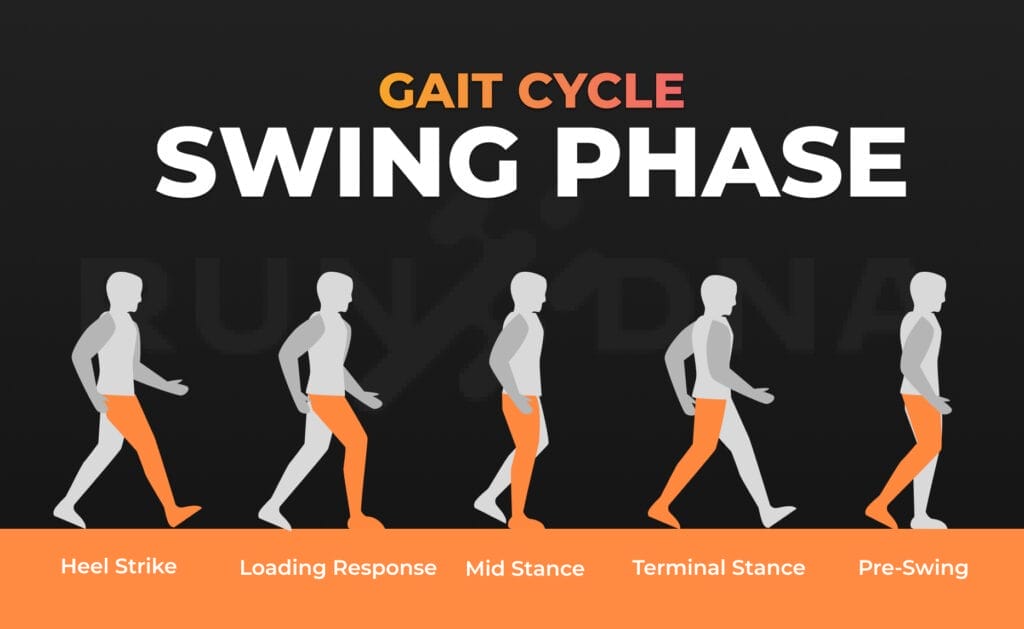The walking gait cycle is a fundamental aspect of human movement, involving a series of phases that ensure efficient and balanced walking. This guide provides a detailed breakdown of each phase, highlighting their importance and how they contribute to effective and healthy walking patterns.
Additionally, understanding the differences between running and walking gait cycles can provide further insight into how these movements impact overall health.
Phases of the Walking Gait Cycle
The walking gait cycle involves examining its two main phases: the stance phase and the swing phase. Understanding these phases and the role of the key muscles involved is essential for diagnosing gait abnormalities and improving walking efficiency and overall mobility.

Stance Phase
The stance phase constitutes about 60% of the walking gait cycle and involves the period when the foot is in contact with the ground. It is divided into several subphases.
- Heel Strike: This initial contact occurs when the heel touches the ground. It is crucial for absorbing shock and setting the stage for the subsequent phases. Key muscles involved include the gluteus maximus, quadriceps femoris, and anterior tibial muscles.
- Loading Response: Following heel strike, the body weight is transferred onto the stance leg, and the foot flattens. This phase involves slight knee flexion to help absorb the impact. Key muscles involved are the quadriceps, gluteus medius, and gastrocnemius.
- Mid-Stance: The body weight is balanced over the stance foot, with the other leg in the swing phase. This phase ensures stability as the body moves forward. The plantar flexors and quadriceps are the primary muscles at work.
- Terminal Stance: The heel begins to lift off the ground as the body moves forward, preparing for the final push-off. Key muscles involved include the gastrocnemius and soleus.
- Pre-Swing (Toe-Off): This phase marks the end of the stance phase as the toes push off the ground, propelling the body forward into the swing phase. Important muscles include the flexor hallucis longus and flexor digitorum longus.
For those interested in a deeper understanding, exploring the science behind gait analysis can shed light on the biomechanics involved in these subphases.

Swing Phase
The swing phase accounts for about 40% of the walking gait cycle and involves the period when the foot is not in contact with the ground. It is divided into three subphases:
- Initial Swing: The leg lifts off the ground and accelerates forward. This phase involves the iliopsoas and rectus femoris muscles to initiate the swing.
- Mid-Swing: The leg continues to move forward, passing under the body. During this phase, the iliopsoas and dorsiflexors are crucial in advancing the leg.
- Terminal Swing: The leg decelerates in preparation for the next heel strike. The hamstrings and quadriceps work to extend the knee and position the foot for landing.
Improving Walking Gait Patterns
By incorporating these strategies, individuals can achieve better movement efficiency, reduce the risk of injuries, and enhance their overall walking gait patterns, which is similar to the benefits of running gait analysis.
Physical Therapy Interventions
Physical therapy is a key approach to improving gait patterns. Therapists design personalized exercise programs to strengthen specific muscles, improve flexibility, and correct movement patterns. The role of gait analysis in physical therapy is crucial as it helps with the following:
- Balance Training: Exercises to enhance stability and coordination.
- Functional Exercises: Activities that mimic daily tasks to improve overall mobility.
- Gait Retraining: Techniques to modify walking patterns and improve gait efficiency.
Orthotic Solutions
Custom orthotic devices can significantly aid in correcting gait abnormalities. These devices are designed to provide support, correct alignment issues, and distribute pressure evenly across the foot. Orthotics can be particularly beneficial for individuals with structural abnormalities such as flat feet or high arches, offering additional support and cushioning to alleviate strain on affected areas.
Strengthening and Flexibility Exercises
Regular exercises aimed at improving muscle strength and flexibility are essential for maintaining proper gait mechanics. Key exercises include:
- Calf Raises: Strengthen the calf muscles, improving push-off power during walking.
- Hamstring Stretches: Enhance flexibility in the hamstrings, allowing for smoother leg movements.
- Hip Strengthening Exercises: Target the hip abductors and adductors to stabilize the pelvis and improve overall balance.
Get Professional Gait Analysis Today!
Understanding the importance of gait analysis and each phase is essential for anyone looking to enhance their movement efficiency and overall well-being. By analyzing these phases, you can identify and correct abnormalities, prevent injuries, and optimize your walking mechanics.
So, take proactive steps to improve your gait by scheduling a professional gait analysis – this investment in your health can lead to significant benefits in mobility and quality of life.
